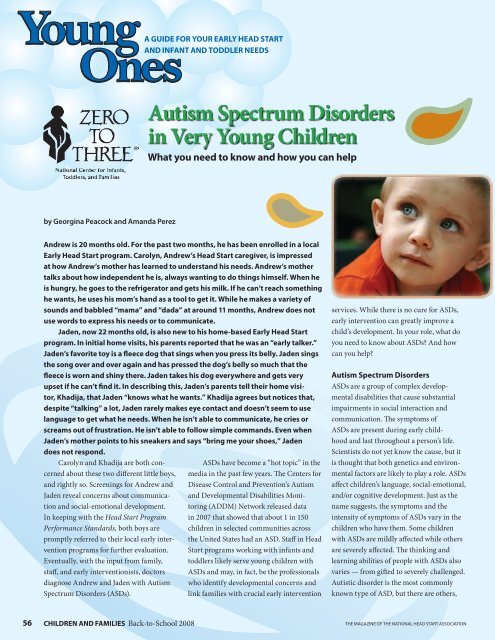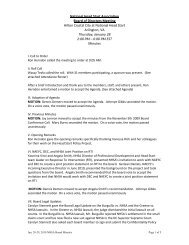New! - National Head Start Association
New! - National Head Start Association
New! - National Head Start Association
Create successful ePaper yourself
Turn your PDF publications into a flip-book with our unique Google optimized e-Paper software.
Young<br />
Ones<br />
56<br />
by Georgina Peacock and Amanda Perez<br />
CHILDREN AND FAMILIES Back-to-School 2008<br />
Autism Spectrum Disorders<br />
in Very Young Children<br />
Andrew is 20 months old. For the past two months, he has been enrolled in a local<br />
Early <strong>Head</strong> <strong>Start</strong> program. Carolyn, Andrew’s <strong>Head</strong> <strong>Start</strong> caregiver, is impressed<br />
at how Andrew’s mother has learned to understand his needs. Andrew’s mother<br />
talks about how independent he is, always wanting to do things himself. When he<br />
is hungry, he goes to the refrigerator and gets his milk. If he can’t reach something<br />
he wants, he uses his mom’s hand as a tool to get it. While he makes a variety of<br />
sounds and babbled “mama” and “dada” at around 11 months, Andrew does not<br />
use words to express his needs or to communicate.<br />
Jaden, now 22 months old, is also new to his home-based Early <strong>Head</strong> <strong>Start</strong><br />
program. In initial home visits, his parents reported that he was an “early talker.”<br />
Jaden’s favorite toy is a eece dog that sings when you press its belly. Jaden sings<br />
the song over and over again and has pressed the dog’s belly so much that the<br />
eece is worn and shiny there. Jaden takes his dog everywhere and gets very<br />
upset if he can’t nd it. In describing this, Jaden’s parents tell their home visitor,<br />
Khadija, that Jaden “knows what he wants.” Khadija agrees but notices that,<br />
despite “talking” a lot, Jaden rarely makes eye contact and doesn’t seem to use<br />
language to get what he needs. When he isn’t able to communicate, he cries or<br />
screams out of frustration. He isn’t able to follow simple commands. Even when<br />
Jaden’s mother points to his sneakers and says “bring me your shoes,” Jaden<br />
does not respond.<br />
Carolyn and Khadija are both concerned<br />
about these two di erent little boys,<br />
and rightly so. Screenings for Andrew and<br />
Jaden reveal concerns about communication<br />
and social-emotional development.<br />
In keeping with the <strong>Head</strong> <strong>Start</strong> Program<br />
Performance Standards, both boys are<br />
promptly referred to their local early intervention<br />
programs for further evaluation.<br />
Eventually, with the input from family,<br />
sta , and early interventionists, doctors<br />
diagnose Andrew and Jaden with Autism<br />
Spectrum Disorders (ASDs).<br />
A GUIDE FOR YOUR EARLY HEAD START<br />
AND INFANT AND TODDLER NEEDS<br />
What you need to know and how you can help<br />
ASDs have become a “hot topic” in the<br />
media in the past few years. e Centers for<br />
Disease Control and Prevention’s Autism<br />
and Developmental Disabilities Monitoring<br />
(ADDM) Network released data<br />
in 2007 that showed that about 1 in 150<br />
children in selected communities across<br />
the United States had an ASD. Sta in <strong>Head</strong><br />
<strong>Start</strong> programs working with infants and<br />
toddlers likely serve young children with<br />
ASDs and may, in fact, be the professionals<br />
who identify developmental concerns and<br />
link families with crucial early intervention<br />
services. While there is no cure for ASDs,<br />
early intervention can greatly improve a<br />
child’s development. In your role, what do<br />
you need to know about ASDs? And how<br />
can you help?<br />
Autism Spectrum Disorders<br />
ASDs are a group of complex developmental<br />
disabilities that cause substantial<br />
impairments in social interaction and<br />
communication. e symptoms of<br />
ASDs are present during early childhood<br />
and last throughout a person’s life.<br />
Scientists do not yet know the cause, but it<br />
is thought that both genetics and environmental<br />
factors are likely to play a role. ASDs<br />
a ect children’s language, social-emotional,<br />
and/or cognitive development. Just as the<br />
name suggests, the symptoms and the<br />
intensity of symptoms of ASDs vary in the<br />
children who have them. Some children<br />
with ASDs are mildly a ected while others<br />
are severely a ected. e thinking and<br />
learning abilities of people with ASDs also<br />
varies — from gi ed to severely challenged.<br />
Autistic disorder is the most commonly<br />
known type of ASD, but there are others,<br />
THE MAGAZINE OF THE NATIONAL HEAD START ASSOCIATION




